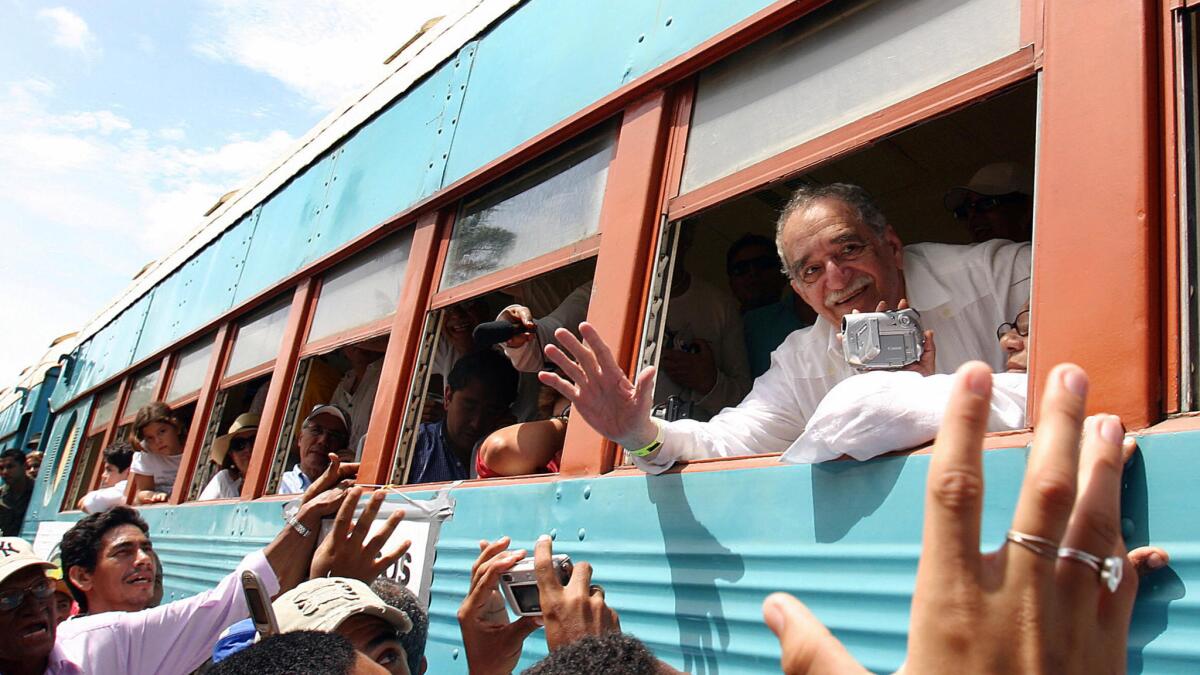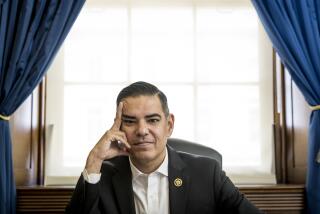ESSAY: What you don’t know about Gabriel Garcia Marquez

When Gabriel García Márquez died in April 2014, Colombia’s president, Juan Manuel Santos Calderón, declared three days of national grieving, citing the Nobel laureate as the “most loved and most admired compatriot of all times.” But the feelings in his hometown were a bit different.
“He isn’t most loved,” Dayvis Sotelo told me 18 months later. “At least not here. He abandoned us.” She tucked a sweaty strand of black hair behind her ear when she spoke, pointing first at the unpaved street and then at an empty water jug next to her. “He left and did nothing for us here.”
Here is Aracataca, the birthplace of García Márquez and the basis for the marvelous Macondo in his most famous novel, “One Hundred Years of Solitude.” Sotelo, a 34-year-old cosmetologist, echoes a sentiment shared by many in the city of 50,000 — a rancor that has not abated in the last three decades, despite the efforts of city officials to create a tourist destination.
Aracataca is home to the Casa Museo García Márquez, the Casa del Telegrafista (where his father worked) and a monument to the author by the train station. In 2006, officials in Aracataca attempted to pass a referendum changing its name to just “Macondo.” After the referendum’s failure, a large banner hung on the main road welcoming the passing motorists to “Aracataca-Macondo: Nobel Land,” and many streets in the town were renamed after characters in his novels, only adding to the general resentment.
Days after García Márquez’s death, and despite competing and higher-profile services in Bogotá and Mexico City, a symbolic funeral began at the church of the author’s baptism and ended at the home of his maternal grandparents.
“Many people turned out,” explained Wilmer Zapata, a 49-year-old store owner who, like many in Latin America, refers to the writer as Gabo. “There were dancers, musicians, singing children – I remember that some local politicians came out and there was a procession. But everyone knew Gabo hadn’t been here in [many] years. Everything was for the publicity, to generate interest in the museum.”
The museum, not surprisingly, has a story worthy of García Márquez.
Gabriel García Márquez lived in his maternal grandparents’ wooden house from his birth in 1927 until he left Aracataca with his parents in 1936. His grandfather died a year later and the house remained in the family, slowly falling into disrepair. Eventually, in the 1960s, the structure succumbed to dilapidation and fire. On its site a new house was built, then demolished in the early aughts to make way for the museum.
The buildings that exist now are modeled on details mined from his fiction, the collected letters of his mother and the recollections of what few of his childhood friends remain. The result is a mishmash of buildings anchored in magical realism and memory. Nothing in the compound is original to García Márquez (not even the color of the walls). Renovations cost $350,000, or about 1.1 billion Colombian pesos. The museum is beautiful, but it also stands in stark contrast to the rest of Aracataca. The buildings people visit memorialize that which never existed—a walk down a bougainvillea-lined hallway taken from a novel written a continent away by a man who hadn’t been back in his hometown since childhood.
For more than a year, Casa Museo García Márquez Director Daniel López lobbied, along with the mayor’s office, to bring some of García Márquez’s ashes to Aracataca. But the García Márquez family preferred to exhibit the remains in Cartagena, where he began his writing career (and kept a home in Colombia until his self-imposed exile in 1981).
There aren’t many options for the curators: Most of García Márquez’s papers and belongings are in the much larger Colombian cities of Cartagena and Barranquilla, in Mexico, and at the Ransom Center at the University of Texas, Austin.
García Márquez approved final blueprints for the museum from his home in Mexico City but provided no other input or financial or public support. He never even visited. He left Aracataca no public works, no schools, no foundation—nothing for his hometown in will, decree or action.
“He couldn’t even leave us some dust,” said Zapata.
Dust, though, is all there is.
A year and a half after García Márquez’s death, I stopped in Aracataca for a meal and ended up spending an afternoon talking to people about García Márquez, violence, and water. Always water.
Two years ago, Aracataca had 40,000 residents. Five years before that the number hovered tens of thousands below, but the population rapidly increased as people displaced by guerrilla forces fled the mountains. In the last 30 years, conflicts between the government, guerrilla forces and the drug trade have displaced an estimated 5.7 million.
Meanwhile Aracataca, in a once lush river valley, now sees rain fall only haphazardly; changes in climate have altered wet and dry seasons on the Caribbean coast of Colombia. The region, dependent on water for agriculture, is unable to provide regular access to clean drinking water to 75% of its population.
And, in a move that’s straight out of Garcia Marquez’s fiction, officials in Aracataca have had several ribbon-cutting ceremonies to begin an aqueduct, initially promised in the 1980s, that still doesn’t exist. The most recent ribbon met oversized scissors in 2012, and still, people drink from the swamps.
“They spent billions on the museum,” local cattleman Pedro Gomez Duarte said, “but they can’t build us an aqueduct? A reservoir? A tank? It’s been decades and people can’t drink clean water, but, ah, the Great Gabo once lived here as a child, so forget about his people — well, like he did.”
The rumors don’t help. García Márquez forever fought the whispers in Colombia about his association with various guerrilla groups. He fled Colombia in 1981, partly due to warnings from his family and friends that he was to be investigated by the army for his ties to M19, a particularly violent organization that popularized kidnappings. A year later, García Márquez won the Nobel Prize for literature and a year after that brought the M19, the ELN, and the notorious FARC to the negotiating table. His involvement in these negotiations, while patriotic to some, seems an indictment to others.
The sources of Aracataca’s resentment seem clear: How could a man who supported the guerrillas — and made money from the magic of this land — give nothing back to his people? But the rumors prove to be just that. Other than a few quotes about being vaguely socialist and apolitical, there’s nothing concrete tying García Márquez to any group.
Nevertheless, rumors and hearsay abound. Over the course of my time in Aracataca, six people told me that García Márquez gave money to the FARC, a crime akin to murder (nothing I turn up verifies this claim). One man told me García Márquez secretly worked for Pablo Escobar as a courier between the drug kingpin and Fidel Castro, which makes sense given the close friendship between the Cuban and García Márquez. A former lieutenant of Escobar’s sold this story to a newspaper years ago and then recanted. In a Colombian move familiar to García Márquez, the Cataqueros (as people of Aracataca are called) insist this fiction reveals a truth greater than fact.
As I drove down the stretch of highway that runs by Aracataca a few days after my first visit, I stared out the window at the banana plantations, now mixed in with African palm (palm oil is one of the main industries listed on the city of Aracataca’s official website). I turned into town and marveled. There were the bones of the United Fruit Co., its massacre of Colombian banana workers forever memorialized in “One Hundred Years of Solitude.” There were the train tracks that carted the bodies toward the Caribbean. There were the canals, the creeping vines, the heat and, yes, the dust floating above the oft-unpaved streets that made Aracataca a bit surreal. There was the building where little García Márquez first saw ice. In this hot town, ice must have been an entirely new universe — the extraordinary revealed in the ordinary. And I felt it: the magic of Aracataca.
I looked for a gift shop for about 20 minutes (none to be found), before I gave up and headed to a small house near the Casa del Telegrafista. I found Dayvis Sotelo on her front step, eager to do something about my American manicure.
She pointed at a mural a few hundred feet away. On it a quote from Gabo:
“I feel [I could be] Latin-American from any country but without renouncing ever my nostalgia for my land: Aracataca, to which I returned one day and discovered that between the reality and nostalgia was the foundation of my work.”
Next to the quote is a cartoonish illustration of the author clapping in wonder as butterflies circle his head.
Sotelo laughed. “It’s a horrible portrait, don’t you think?”
Adriana E. Ramírez is a 2015 PEN/Fusion Award-winning nonfiction writer and performance poet based in Pittsburgh. She teaches in the English Department at the University of Pittsburgh, works at the Pittsburgh Poetry Collective and co-founded Aster(ix) Journal.
More to Read
Sign up for our Book Club newsletter
Get the latest news, events and more from the Los Angeles Times Book Club, and help us get L.A. reading and talking.
You may occasionally receive promotional content from the Los Angeles Times.







